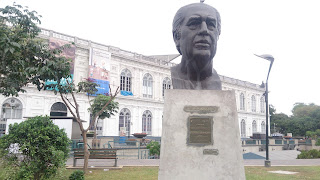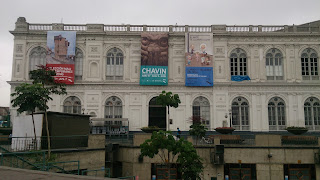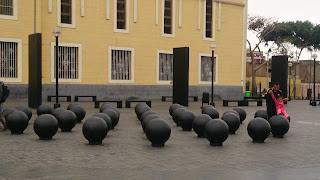Lima may be a tropical capital, but its climate would hardly give that away. For over half the year - April through November - the city is draped in a damp blanket of low cloud called garúa. Cool temperature with highs around 18°C accompany the dreary weather, created by condensation above the cold Humboldt Current off the coast. Rainfall hardly amounts to more than a few nights of drizzle, however. November through April, the summer months, are pleasant, with highs rarely topping 27°C.
Museum of Art of Lima - MALI
On the other side of the street of the hostel I stayed
Today, I would like to go to visit some tourist spots near Plaza de Armas. On the way, I passed through a newly opened mall near Centro de Lima.
Many eateries in the mall
and a supermarket
Paseo de los Heroes Navales
Fire station
Historic Lima
Under the auspices of Unesco it has been declared part of the "Cultural Heritage of mankind", and there have been spectacular changes in both architectural restoration and street cleanliness and security.
Most of Lima's colonial-era churches and mansions are in El Centro, along the Plaza de Armas. From there a speedy expressway called Paseo de la Republica (aka Via Express) or a traffic-clogged thoroughfare called Avenida Arequipa takes you south to San Isidro and Miraflores. two fairly upscale neighborhoods where you'll find the bulk of the city's dining and lodging options. East of Miraflores is Barranco, where colonial architecture is complemented by a bohemian ambience.
Plaza San Martín
South of Plaza Mayor, the largest square and hub of Lima's first expansion is the Plaza San Martin. It's best approached via the pedestrianized Jirón de la Unión, once Lima's most elegant shopping street, now a teeming mass of shoppers and fast-food joints. The colonnaded Plaza San Martín, restored and repainted and brightly lit, is an important gathering place for political meetings. In the Center is an equestrian statue of General José de San Martín, Peru's Argentinian independence hero.
On its west side is the Gran Hotel Bolívar. Built in the 1920s, it retains much of its former atmosphere.
Plaza de Armas / Plaza Mayor
Stand in the middle of this handsome square, by the 17th-century bronze fountain, and it is the city's historic heart. The Angel of Fame on the fountain is a copy of the original that, according to legend, flew away in 1900.
The eastern side of the square is dominated by the Catedral San Juan Evangelista,
Municipalidad de Lima (City Hall)
There is a library inside
Municipal Palace of Lima / Palacio de Gobierno
There is a free 2-hour guided tour with a copy of passport and registered one-day before.
At 11:45am, every day except Sunday, Changing of the Guard performs in the front courtyard by goose-stepping troops from the Húsares de Junín regiment, dressed in the red-and-blue ceremonial uniforms and ornamental helmets of the independence period.
The oldest building of the square, the Casa del Oidor, is on the right side of the photo. Dating from the early 18th century, it has the wooden balconies in the form of enclosed galleries projecting from the first floor that were colonial Lima's most graceful feature.
Lots of people already there to watch the match, I slipped to the side
Other buildings around the plaza including the post office
Desamparados Station - an old train station turned cultural centre Casa de la Literatura Peruana
At the back of the palace, there lays an express way - Panamericana Norte
and a pleasant walkway
Along the hillside, there is a shanty area for the poor.
Pueblos jóvenes
Many Andean communities suffered greatly during the 20th century, and between the 1960s and 1980s Lima seemed like a promised land to the rural poor. Thousands of migrants gradually filled the city with a huge Andean population. Urban authorities were unable to satisfy the basic needs of these migrants, and thus the pueblos jóvenes, or shantytowns, surrounding Lima came into being, They started as squatter settlements of rush-matting huts, but decades of hard work have turned some into pleasant districts, Many others remain desperately poor, lacking electricity, piped water, or paved streets.
Correo Central
Inaugurated in 1924, this regal structure looks more like a palace than a post office.





























沒有留言:
張貼留言